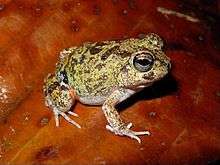Leiuperinae
The Leiuperinae are a subfamily of frogs in the family Leptodactylidae. Over 90 species are in five genera. The distribution of this subfamily is from southern Mexico to the Central America and much of South America.[1]
| Leiuperinae | |
|---|---|
 | |
| Pleurodema brachyops | |
| Scientific classification | |
| Kingdom: | Animalia |
| Phylum: | Chordata |
| Class: | Amphibia |
| Order: | Anura |
| Family: | Leptodactylidae |
| Subfamily: | Leiuperinae Bonaparte, 1850 |
| Type genus | |
| Leiuperus Duméril and Bibron, 1841 | |
| Synonyms | |
|
Leiuperina Bonaparte, 1850 | |
Taxonomy
Recognition of the Leiuperinae as it is known today is relatively recent. Frost et al. (2006) treated the Leiuperina as a part of the Leptodactylidae,[2] whereas Grant et al. (2006) recognized them as a family,[3] the view adopted by some sources.[4][5] However, the Amphibian Species of the World follows Pyron and Wiens (2011)[6] in recognizing this taxon as a subfamily.[1] However, AmphibiaWeb includes leiuperinid genera in the Leptodactylidae, without recognizing them as a subfamily.[7]
Genera
The five genera are:[1]
- Edalorhina Jiménez de la Espada, 1870
- Engystomops Jiménez de la Espada, 1872
- Physalaemus Fitzinger, 1826
- Pleurodema Tschudi, 1838
- Pseudopaludicola Miranda-Ribeiro, 1926
References
- Frost, Darrel R. (2015). "Leiuperinae Bonaparte, 1850". Amphibian Species of the World: an Online Reference. Version 6.0. American Museum of Natural History. Retrieved 23 May 2015.
- Frost, D. R.; Grant, T.; Faivovich, J. N.; Bain, R. H.; Haas, A.; Haddad, C. L. F. B.; De Sá, R. O.; Channing, A.; Wilkinson, M.; Donnellan, S. C.; Raxworthy, C. J.; Campbell, J. A.; Blotto, B. L.; Moler, P.; Drewes, R. C.; Nussbaum, R. A.; Lynch, J. D.; Green, D. M.; Wheeler, W. C. (2006). "The Amphibian Tree of Life". Bulletin of the American Museum of Natural History. 297: 1–291. doi:10.1206/0003-0090(2006)297[0001:TATOL]2.0.CO;2. hdl:2246/5781.
- Grant, T., Frost, D. R., Caldwell, J. P., Gagliardo, R., Haddad, C. F. B., Kok, P. J. R., Means, D. B., Noonan, B. P., Schargel, W. E., and Wheeler, W. C. (2006). "Phylogenetic systematics of dart-poison frogs and their relatives (Amphibia: Athesphatanura: Dendrobatidae)" (PDF). Bulletin of the American Museum of Natural History. 299: 1–262. doi:10.1206/0003-0090(2006)299[1:PSODFA]2.0.CO;2.CS1 maint: multiple names: authors list (link)
- Blackburn, D.C.; Wake, D.B. (2011). "Class Amphibia Gray, 1825. In: Zhang, Z.-Q. (Ed.) Animal biodiversity: An outline of higher-level classification and survey of taxonomic richness" (PDF). Zootaxa. 3148: 39–55.
- "Leipueridae". Animal Diversity. Retrieved May 19, 2015.
- Pyron, A. R.; Wiens, J. J. (2011). "A large-scale phylogeny of Amphibia including over 2800 species, and a revised classification of extant frogs, salamanders, and caecilians". Molecular Phylogenetics and Evolution. 61 (2): 543–583. doi:10.1016/j.ympev.2011.06.012. PMID 21723399.
- "Leptodactylidae". AmphibiaWeb: Information on amphibian biology and conservation. [web application]. Berkeley, California: AmphibiaWeb. 2015. Retrieved 22 May 2015.